How to Use Sudoku Candidate Mode (with Examples)
Candidate mode is a powerful feature in electronic Sudoku puzzles that mimics using pencil marks in a hardcopy puzzle. It allows you to mark possible candidates in each cell with small numbers. Keeping track of these options helps you place and eliminate candidates as you work your way through the puzzle.
In addition, by having all the possibilities marked with candidate mode, you can easily find the last possible candidate for a cell or identify naked pairs and other patterns that create a foundation for Sudoku strategies.
Whether you’re a beginner working with easy puzzles or are making your way through more difficult ones, using candidate mode is an effective way to keep track of your progress and solve puzzles more efficiently.
How to Use Candidate Mode
For Sudoku Bliss, using candidate mode is simple. You simply check a box to turn candidate mode on and off. This way, when you click into a cell, you’re not placing an answer. You’re placing a candidate, a possible answer.
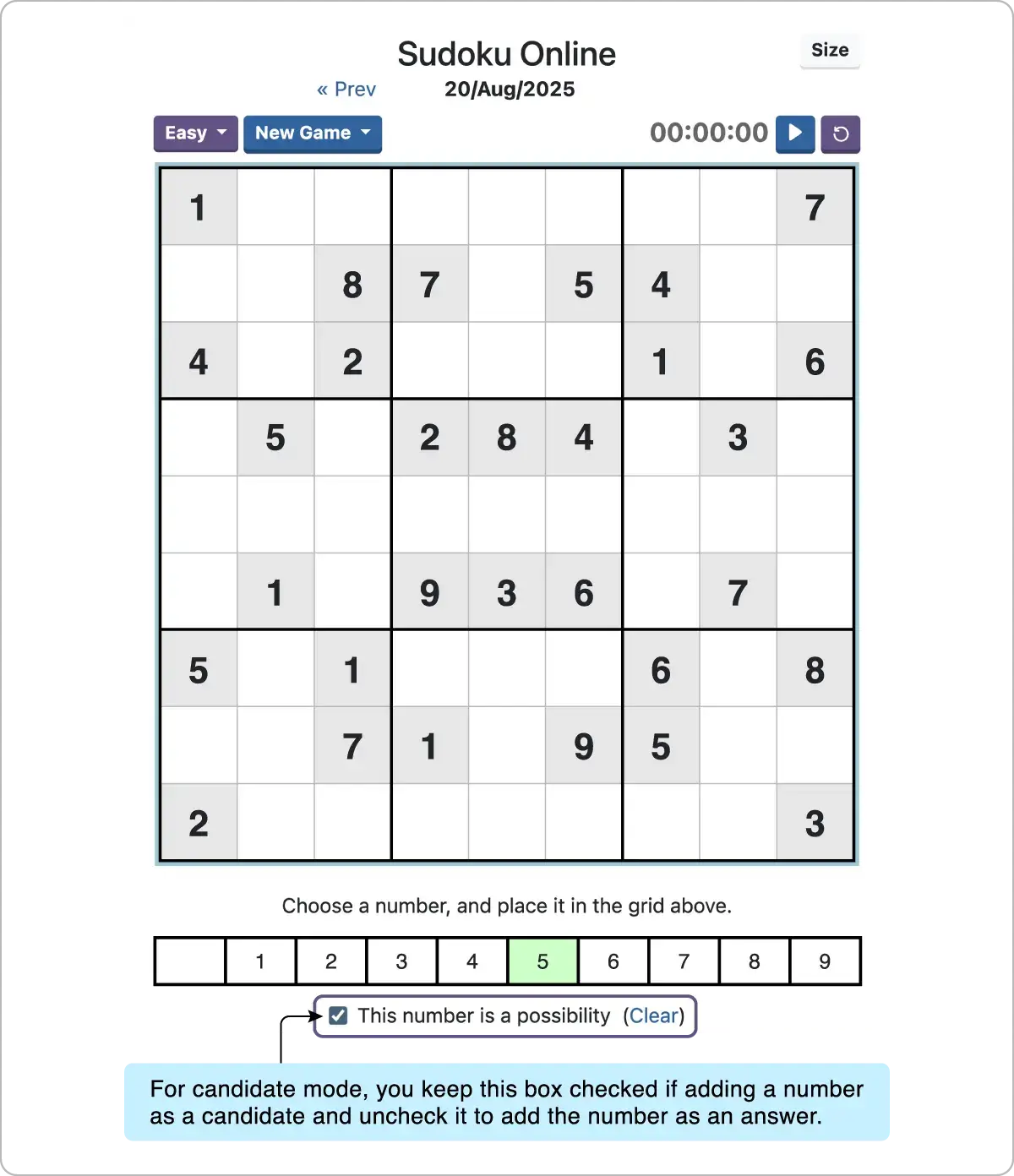
To use candidate mode, follow these steps:
- Identify a candidate for a cell. For example, in the top right 3x3 block 5 can only be a candidate in cells H1 and H3 because the 5 in row 2 (cell F2) and the 5 in column G (cell G8) eliminates the possibility of 5s being in that row or column.
- Check the box that reads, “This number is a possibility.”
- Highlight the candidate number in the bar under the Sudoku grid. Because you need to place 5 as a possible candidate in those two cells (H1 and H3), highlight 5.
- Click once in the cell you want the candidate to be placed in. Clicking into H1 and H3 places a small 5 in the corner of each cell. The green cell is simply the last place you clicked.
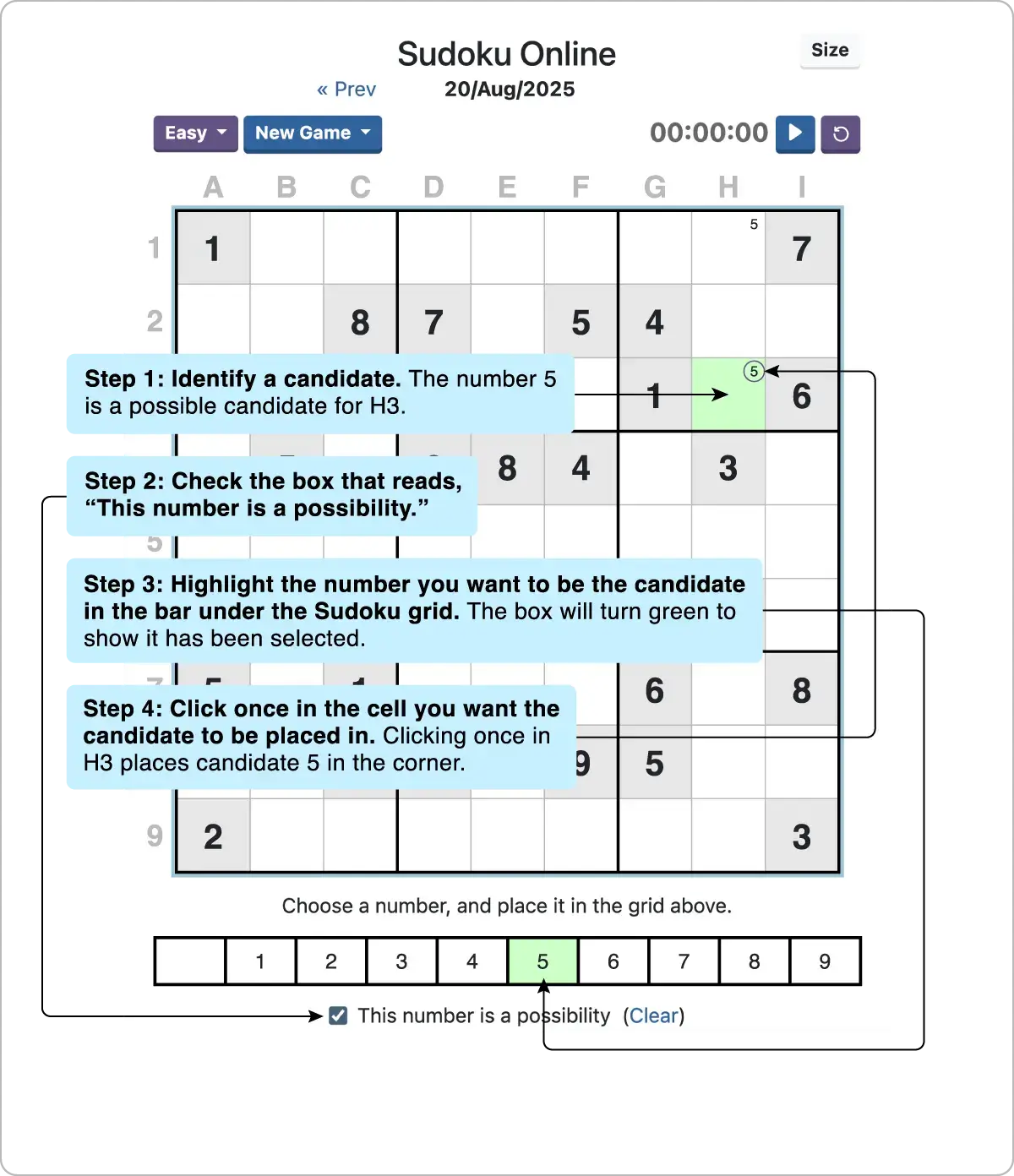
If you want to remove a candidate from a cell, you follow the same process. To remove all candidates from the grid, you can click the “Clear” option next to “This number is a possibility.”
Candidate mode is most effective when you can narrow down a cell’s possibilities to two to three candidates but can’t track the possibilities by memory. This allows you to move around the puzzle to find placements and eliminations quickly.
If you’re a beginner, you may find yourself marking every candidate in every cell until you get more comfortable with the logic. This gives you plenty of practice with scanning units and looking for patterns that support basic solving techniques. But candidate mode can also help you level up with more advanced strategies, such as X-wing and swordfish.
Candidate Mode Examples
Using candidate mode is a powerful technique for solving Sudoku puzzles, but it can get overwhelming and end up being more confusing if you don’t follow a system. These sections offer some examples of using candidate mode that can help keep you on track.
Adding Candidates
When you scan units in a puzzle, you may not immediately discover answers for each empty cell. But to narrow down the possibilities, you can pop in candidates to help highlight answers, eliminations, and patterns useful for advanced techniques.
For example, in the top left 3x3 block, adding candidates helped to discover that 7 was the only possible answer for cell B3, and 5 could only be placed into C1. Now this block has only three cells without answers.
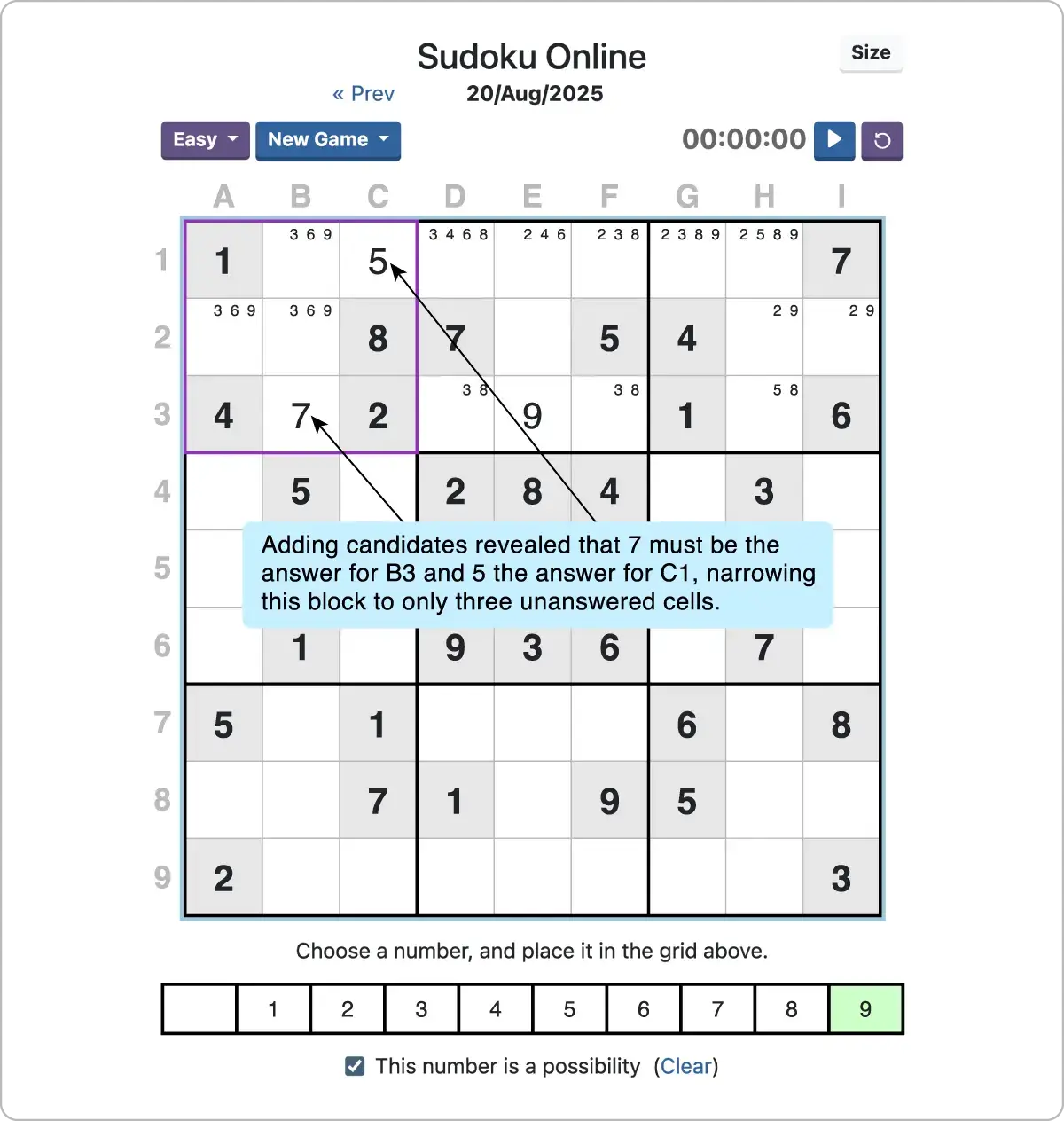
Finding Singles
Adding candidates helps you find naked or hidden singles. A naked single will be the only candidate in a cell for a unit, and a hidden single will appear just once as a candidate in a unit, but it may be hidden by other candidates in the cell.
For example, cell H3 has two candidates listed (5 and 8). But 5 appears as a candidate just once in row 3 after all candidates have been marked. So 5 must be the answer to H3.
Additionally, cell G1 is the only place in that 3x3 block that has 3 as a candidate. Even though other candidates appear in the cell, it’s the only place a 3 can go for that block, making 3 the answer for that cell.
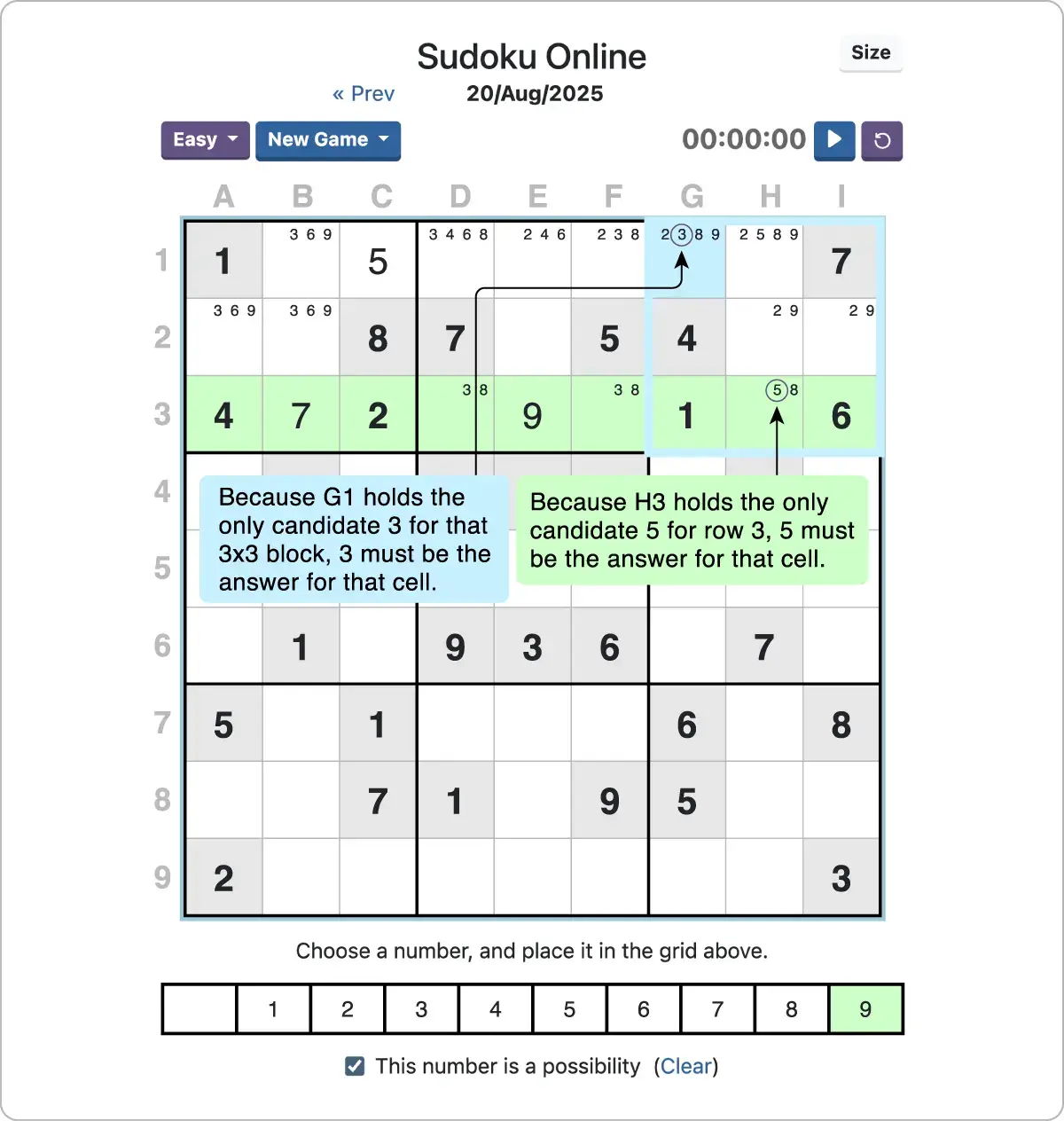
Try finding the naked single in the sudoku puzzle below. Click the Hint button to see if you properly identified it.
Updating Candidates
When you answer a cell, scan intersecting units to see if you can eliminate any candidates. This allows you to narrow down possibilities even further and maybe find additional answers.
For example, when 5 was added as the answer for H3, then all the candidate 5s that shared a unit with H3 could be erased.
The same goes for candidate 3. As the answer for cell G1, 3 can be erased from any unit shared with that cell. Updating these candidates helps narrow down the possibilities in adjoining units.
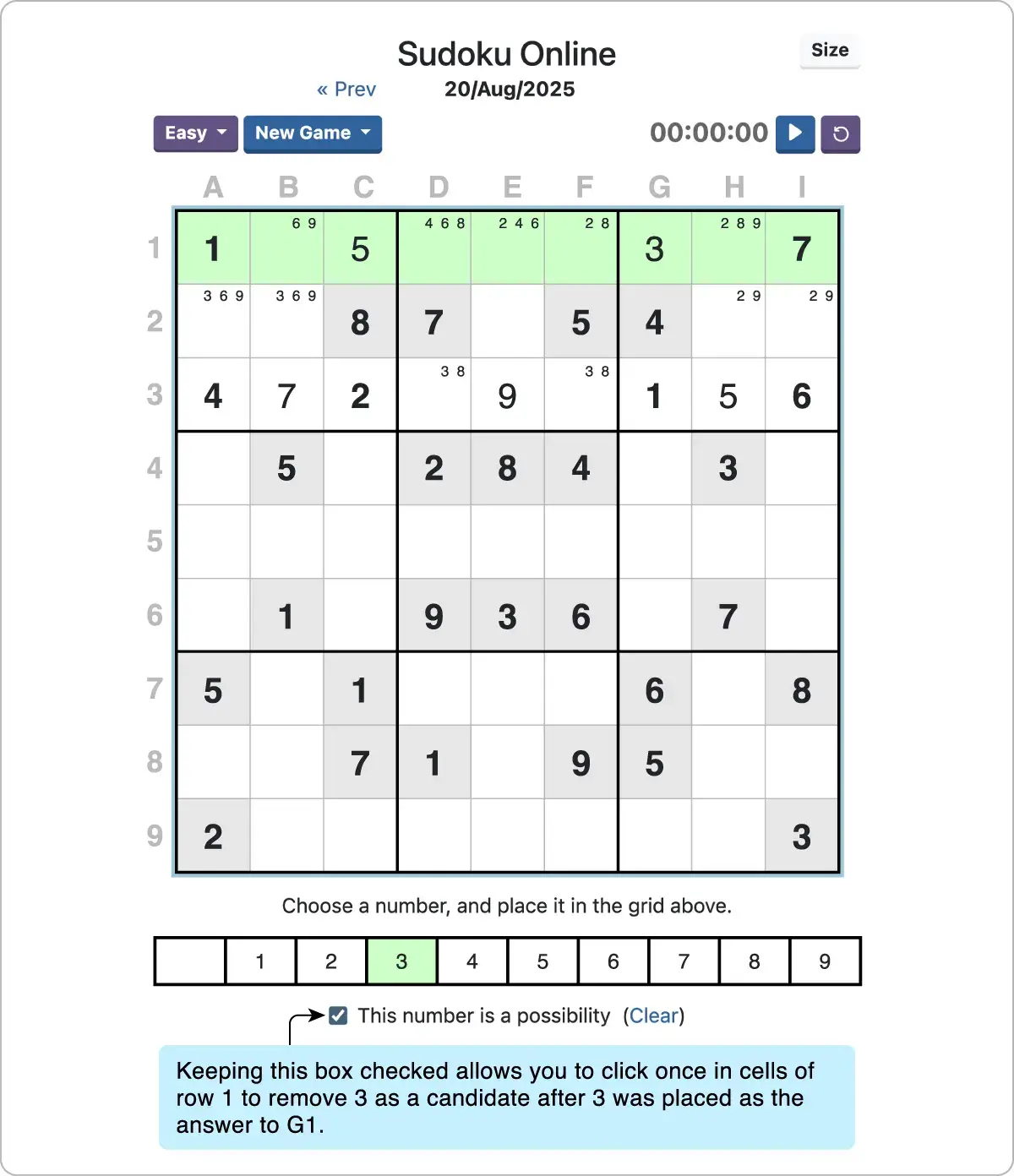
Strategies to Use with Candidate Mode
Candidate mode is a powerful tool no matter what level of solver you are because many Sudoku strategies rely on knowing the possible candidates for certain cells. Using candidate mode can help you level up to new levels of difficulty and solve hard Sudoku puzzles.
- Naked pairs are when two cells within one unit both have only the same two candidate numbers. Because the cells have no other candidate numbers in them, you can eliminate those two numbers as candidates in other cells within the unit. Naked triples are similar to pairs but three cells contain a subset of the same three candidates.
- Hidden pairs is a technique that simply adds another layer to naked pairs. You still have only two cells in one unit sharing the same two candidate numbers, but the pairs are hidden because other candidates are in those cells as well.
- Hidden triples take naked triples a step further. Three cells in the same unit contain a subset of the same three candidates, but those cells are “hiding” the candidates because other candidates are placed there, too. If you find hidden triples, you can eliminate the other candidates that are hiding the triples within those cells.
- X-wing requires you to find a candidate that appears exactly twice in two rows (or columns) with those four occurrences lining up to create four points of a rectangle. If you find an X-wing, you can eliminate that candidate outside of the pattern. Swordfish takes the strategy one step further by adding another row (or column) to the pattern.
- A locked candidate is confined to just one row or column of an overlapping block or appears in just one block along an overlapping row or column. Because the candidate is confined to that intersection, you can eliminate it from other cells in the unit outside of that overlap.
- Y-wing (also called XY-wing) requires that you find a bivalue (two-candidate) pivot cell with candidates x and y. That cell must share a unit with two other bivalue cells that act as pincer cells. The pincer cells do not share a unit with each other, but they do share a third candidate (z). And each pincer cell contains one of the candidates from the pivot cell, so one pincer is x and z and the other pincer is y and z. In this pattern, you can eliminate the shared candidate (z) of the pincer cells from any cells that both pincers share a unit with.
If you’re tired of using trial and error to place candidates, then using candidate mode when you play Sudoku online can be an effective way to solve more puzzles more efficiently.